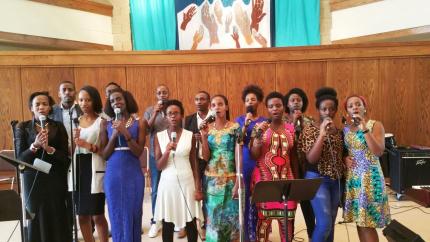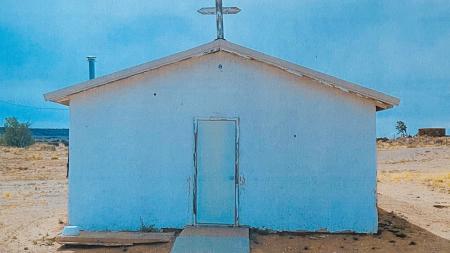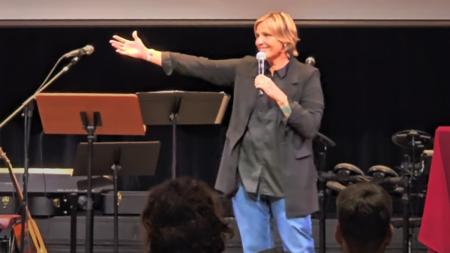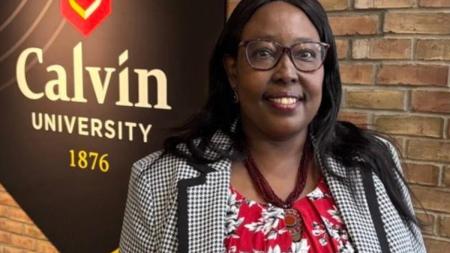Finding a Nesting Place

The choir sings at Kinyarwanda Church.
Kinyarwanda Church
Several immigrant families from East Africa have found a “nest” in which they can gather for worship on Sunday afternoons at Oakdale Park Christian Reformed Church in Grand Rapids, Mich.
Reflecting a church-planting trend called “nesting,” which is showing up in other CRC congregations as well, they have found a place for themselves in an already established church that has opened its doors and provided a space to meet.
“We are so grateful for [Oakdale Park’s] welcoming heart,” said Pastor Maseruka “Claude” Ngendachayo, whose congregation is made up of immigrants from Rwanda.
The goal of his church, he said, is to bring together people who were forced to escape their homeland during the Rwandan genocide of 1994. Many have settled in the U.S.
“We needed a place where we could pray and worship and express ourselves to God,” said Ngendachayo.
Oakdale Park has done more than simply provide space, however. It is also in the process of bringing the congregation into the full life of its church, said Rev. Emmett Harrison, pastor of Oakdale.
For instance, the two bodies have met for joint services and other activities. In addition, Oakdale has provided instruments for Ngendachayo’s church -- which is called Kinyarwanda, the same name as the national language of Rwanda -- to use for worship.
Oakdale has also assisted the nesting group with administrative matters, and is cosponsoring a large revival event with the Kinyarwanda congregation on the last weekend of July.
“Our posture is to have them join with us so that we will eventually be one congregation speaking two languages and representing two different cultures,” said Harrison.
Nesting
The root concept in nesting is that it can be a form of church planting; nesting can be used for developing or incubating various types of church plants, said Rev. Jul Medenblik, president of Calvin Theological Seminary.
“I came across this concept as part of my church planting leader work with Home Missions,” he said.
Especially in an age when older churches are seeking ways to grow and to reach out to their communities, this approach can be useful, he said.
This church-planting concept can take on many different variations and challenges, depending on the circumstances of the churches involved.
Several years ago, Harderwyk Ministries in Holland, Mich. made room on its campus for Watershed, a church plant focusing on young adults.
After a time, Watershed became an organized CRC congregation that is today part of Harderwyk, said Rev. John Burden, teaching pastor for Watershed.
It has been a long process and has faced some difficulties along the way, but the arrangement is working out.
“Being open to where God is leading has been key for us as we have grown into this,” said Burden, adding that he is aware of other nesting-like situations that have not done as well.
Amy Schenkel, Great Lakes Regional Leader for Christian Reformed Home Missions, said nesting applies especially well to immigrant groups looking for a place to worship inside CR church buildings.
“Often these groups come to North America as Christians, and they gather together in these congregations for community and worship,” she said.
“Connecting with these groups is more of a call to hospitality, and sometimes they are adopted into or decide to become affiliated with the CRC because of that relationship.”
For instance, Princeton CRC in Grand Rapids hosted a congregation of ethnic Chin members. For a time, the Chin congregation was considered to be emerging, said Schenkel.
But once the Chin congregation stabilized, it became an established CR church. For now, it still meets at Princeton, though it may one day decide to move to its own building.
Keith Doornbos, director of the Renewal Lab, a church planting program at Calvin Theological Seminary, said he worked earlier this year with Sunnyside CRC in Sunnyside, Wash., which fits this profile of nesting.
When the church began to see an increase in the number of Hispanic people coming into its area, it reached out and offered the new residents a place to worship. To start, the established church met in the morning, and the Hispanic congregation worshiped in the afternoon in the same building.
Then the established church constructed a new facility, with the longtime members worshiping in the main sanctuary and the Hispanic church worshiping in a chapel set aside for them.
They hold services at the same time on Sundays and meet in the narthex afterward for fellowship. At this point, says a member of the Hispanic congregation, the Hispanic church is not formally affiliated with the CRC, but they have developed close ties and have discussed entering into a tighter relationship in the future.
Rich in diversity
Pastor Claude Ngendachayo, an ordained Pentecostal preacher, arrived in Grand Rapids with his family in 2013 from Africa. With plans to start a congregation, he connected with a few families from his homeland of Rwanda.
They started to meet for prayer and soon began looking for a place to worship. Nothing came up that met their needs.
Then one day Ngendachayo, who lives in the neighborhood near Oakdale Park CRC, decided to send his son, Paul, over to the church to talk to the pastor. His son helped to set up a meeting between Harrison and his father.
Harrison was immediately open to taking the African congregation under Oakdale’s wing and brought the matter to his church council, which was also in favor of building a relationship.
Oakdale Park soon discussed the relationship with Classis Grand Rapids East, and the classis awarded funds to help build ties between the congregations.
“I was a visitor in this country and didn’t know what would happen for us,” said Ngendachayo. “We had thought it would take a long time before we could worship in a church.”
But then he met Harrison, and the Kinyarwanda group were soon worshiping in their new space, holding a service in their own language full of song and dance and high energy every Sunday.
“They helped us to solve all our problems. We are so grateful to God for this,” he said.
JacQues Ingabire is a worship leader for this East African congregation. He, too, is happy that they have a place for their ministry.
“When people come here, they can get connected to the Lord,” he said. “Our hope is that the message from the songs and other parts of worship can change people’s hearts.”
Today the two churches are deeply committed to one another and to living out that commitment in one facility. What began as one church “nesting” within the other is moving toward a full relationship in which the African church will likely join the CRC, said Harrison.
Having the African congregation worship in the building, among other things, has helped to enhance the spiritual life of Oakdale members. It has especially given them appreciation for a group of people from another country and their unfamiliar, Pentecostal-style of worship, said Harrison,
“They have added a tremendous gift of diversity to our congregation. They bring a range of spiritual gifts—and enthusiasm. These brothers and sisters help us to see God from a vantage point that is different from what we tend to see here in North America,” said Harrison.


